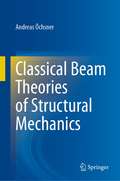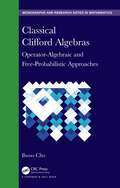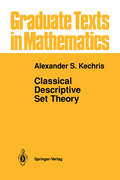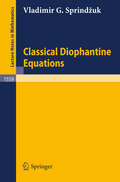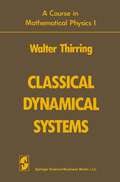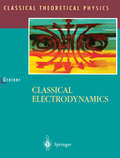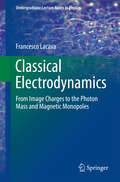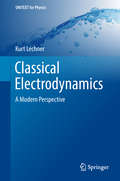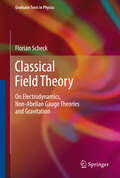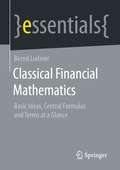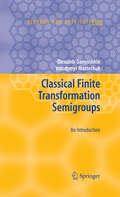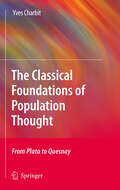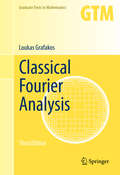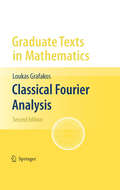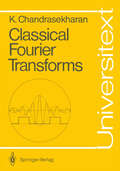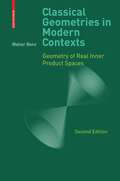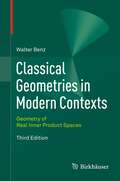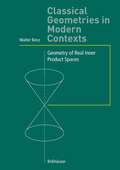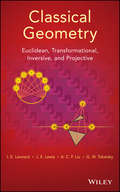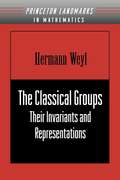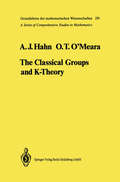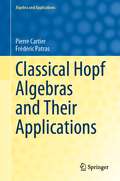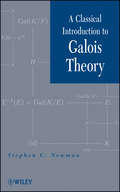- Table View
- List View
Classical Beam Theories of Structural Mechanics
by Andreas ÖchsnerThis book provides a systematic and thorough overview of the classical bending members based on the theory for thin beams (shear-rigid) according to Euler-Bernoulli, and the theories for thick beams (shear-flexible) according to Timoshenko and Levinson. The understanding of basic, i.e., one-dimensional structural members, is essential in applied mechanics. A systematic and thorough introduction to the theoretical concepts for one-dimensional members keeps the requirements on engineering mathematics quite low, and allows for a simpler transfer to higher-order structural members. The new approach in this textbook is that it treats single-plane bending in the x-y plane as well in the x-z plane equivalently and applies them to the case of unsymmetrical bending. The fundamental understanding of these one-dimensional members allows a simpler understanding of thin and thick plate bending members.Partial differential equations lay the foundation to mathematically describe the mechanical behavior of all classical structural members known in engineering mechanics. Based on the three basic equations of continuum mechanics, i.e., the kinematics relationship, the constitutive law, and the equilibrium equation, these partial differential equations that describe the physical problem can be derived. Nevertheless, the fundamental knowledge from the first years of engineering education, i.e., higher mathematics, physics, materials science, applied mechanics, design, and programming skills, might be required to master this topic.
Classical Clifford Algebras: Operator-Algebraic and Free-Probabilistic Approaches (Chapman & Hall/CRC Monographs and Research Notes in Mathematics)
by Ilwoo ChoClassical Clifford Algebras: Operator-Algebraic and Free-Probabilistic Approaches offers novel insights through operator-algebraic and free-probabilistic models. By employing these innovative methods, the author sheds new light on the intrinsic connections between Clifford algebras and various mathematical domains. This monograph should be an essential addition to the library of any researchers interested in Clifford Algebras or Algebraic Geometry more widely.Features Includes multiple examples and applications Suitable for postgraduates and researchers working in Algebraic Geometry Takes an innovative approach to a well-established topic.
Classical Clifford Algebras: Operator-Algebraic and Free-Probabilistic Approaches (Chapman & Hall/CRC Monographs and Research Notes in Mathematics)
by Ilwoo ChoClassical Clifford Algebras: Operator-Algebraic and Free-Probabilistic Approaches offers novel insights through operator-algebraic and free-probabilistic models. By employing these innovative methods, the author sheds new light on the intrinsic connections between Clifford algebras and various mathematical domains. This monograph should be an essential addition to the library of any researchers interested in Clifford Algebras or Algebraic Geometry more widely.Features Includes multiple examples and applications Suitable for postgraduates and researchers working in Algebraic Geometry Takes an innovative approach to a well-established topic.
Classical Descriptive Set Theory (Graduate Texts in Mathematics #156)
by Alexander KechrisDescriptive set theory has been one of the main areas of research in set theory for almost a century. This text presents a largely balanced approach to the subject, which combines many elements of the different traditions. It includes a wide variety of examples, more than 400 exercises, and applications, in order to illustrate the general concepts and results of the theory.
Classical Diophantine Equations (Lecture Notes in Mathematics #1559)
by Vladimir G. SprindzukThe author had initiated a revision and translation of "Classical Diophantine Equations" prior to his death. Given the rapid advances in transcendence theory and diophantine approximation over recent years, one might fear that the present work, originally published in Russian in 1982, is mostly superseded. That is not so. A certain amount of updating had been prepared by the author himself before his untimely death. Some further revision was prepared by close colleagues. The first seven chapters provide a detailed, virtually exhaustive, discussion of the theory of lower bounds for linear forms in the logarithms of algebraic numbers and its applications to obtaining upper bounds for solutions to the eponymous classical diophantine equations. The detail may seem stark--- the author fears that the reader may react much as does the tourist on first seeing the centre Pompidou; notwithstanding that, Sprind zuk maintainsa pleasant and chatty approach, full of wise and interesting remarks. His emphases well warrant, now that the book appears in English, close studyand emulation. In particular those emphases allow him to devote the eighth chapter to an analysis of the interrelationship of the class number of algebraic number fields involved and the bounds on the heights of thesolutions of the diophantine equations. Those ideas warrant further development. The final chapter deals with effective aspects of the Hilbert Irreducibility Theorem, harkening back to earlier work of the author. There is no other congenial entry point to the ideas of the last two chapters in the literature.
Classical Electrodynamics (Classical Theoretical Physics)
by Walter GreinerThis reference and workbook provides not only a complete survey of classical electrodynamics, but also an enormous number of worked examples and problems to show the reader how to apply abstract principles to realistic problems. The book will prove useful to graduate students in electrodynamics needing a practical and comprehensive treatment of the subject.
Classical Electrodynamics: From Image Charges to the Photon Mass and Magnetic Monopoles (Undergraduate Lecture Notes in Physics)
by Francesco LacavaThis book proposes intriguing arguments that will enable students to achieve a deeper understanding of electromagnetism, while also presenting a number of classical methods for solving difficult problems. Two chapters are devoted to relativistic electrodynamics, covering all aspects needed for a full comprehension of the nature of electric and magnetic fields and, subsequently, electrodynamics. Each of the two final chapters examines a selected experimental issue, introducing students to the work involved in actually proving a law or theory. Classical books on electricity and magnetism are mentioned in many references, helping to familiarize students with books that they will encounter in their further studies. Various problems are presented, together with their worked-out solutions. The book is based on notes from special lectures delivered by the author to students during the second year of a BSc course in Physics, but the subject matter may also be of interest to senior physicists, as many of the themes covered are completely ignored or touched only briefly in standard textbooks.
Classical Electrodynamics: A Modern Perspective (UNITEXT for Physics)
by Kurt LechnerThis book addresses the theoretical foundations and the main physical consequences of electromagnetic interaction, generally considered to be one of the four fundamental interactions in nature, in a mathematically rigorous yet straightforward way. The major focus is on the unifying features shared by classical electrodynamics and all other fundamental relativistic classical field theories. The book presents a balanced blend of derivations of phenomenological predictions from first principles on the one hand, and concrete applications on the other. Further, it highlights the internal inconsistencies of classical electrodynamics, and addresses and resolves often-ignored critical issues, such as the dynamics of massless charged particles, the infinite energy of the electromagnetic field, and the limits of the Green’s function method. Presenting a rich, multilayered, and critical exposition on the electromagnetic paradigm underlying the whole Universe, the book offers a valuable resource for researchers and graduate students in theoretical physics alike.
Classical Field Theory: On Electrodynamics, Non-Abelian Gauge Theories and Gravitation (Graduate Texts in Physics)
by Florian ScheckThe book describes Maxwell's equations first in their integral, directly testable form, then moves on to their local formulation. The first two chapters cover all essential properties of Maxwell's equations, including their symmetries and their covariance in a modern notation. Chapter 3 is devoted to Maxwell theory as a classical field theory and to solutions of the wave equation. Chapter 4 deals with important applications of Maxwell theory. It includes topical subjects such as metamaterials with negative refraction index and solutions of Helmholtz' equation in paraxial approximation relevant for the description of laser beams.Chapter 5 describes non-Abelian gauge theories from a classical, geometric point of view, in analogy to Maxwell theory as a prototype, and culminates in an application to the U(2) theory relevant for electroweak interactions. The last chapter 6 gives a concise summary of semi-Riemannian geometry as the framework for the classical field theory of gravitation. The chapter concludes with a discussion of the Schwarzschild solution of Einstein's equations and the classical tests of general relativity (perihelion precession of Mercury, and light deflection by the sun).------Textbook features: detailed figures, worked examples, problems and solutions, boxed inserts, highlighted special topics, highlighted important math etc., helpful summaries, appendix, index.
Classical Financial Mathematics: Basic Ideas, Central Formulas and Terms at a Glance (essentials)
by Bernd LudererThis essential teaches basic formulas, methods and ideas of classical financial mathematics. Since classical financial mathematics makes do with elementary mathematical tools, any interested reader with average mathematical school knowledge can easily follow this text. The core of the text is the calculation of interest and compound interest, annuity calculation, amortization calculation and price calculation. A large number of practical examples illustrate the mathematical questions.This Springer essential is a translation of the original German 1st edition essentials, Klassische Finanzmathematik by Bernd Luderer, published by Springer Fachmedien Wiesbaden GmbH, part of Springer Nature in 2019. The translation was done with the help of artificial intelligence (machine translation by the service DeepL.com). A subsequent human revision was done primarily in terms of content, so that the book will read stylistically differently from a conventional translation. Springer Nature works continuously to further the development of tools for the production of books and on the related technologies to support the authors.
Classical Finite Transformation Semigroups: An Introduction (Algebra and Applications #9)
by Olexandr Ganyushkin Volodymyr MazorchukThe aim of this monograph is to give a self-contained introduction to the modern theory of finite transformation semigroups with a strong emphasis on concrete examples and combinatorial applications. It covers the following topics on the examples of the three classical finite transformation semigroups: transformations and semigroups, ideals and Green's relations, subsemigroups, congruences, endomorphisms, nilpotent subsemigroups, presentations, actions on sets, linear representations, cross-sections and variants. The book contains many exercises and historical comments and is directed first of all to both graduate and postgraduate students looking for an introduction to the theory of transformation semigroups, but also to tutors and researchers.
The Classical Foundations of Population Thought: From Plato to Quesnay
by Yves CharbitWhereas the history of demography as a social science has been amply explored, that of the construction of the concept of population has been neglected. Specialists systematically ignore a noteworthy paradox: strictly speaking, the great intellectual figures of the past dealt with in this book have not produced demographic theories or doctrines as such, but they have certainly given some thought to population at both levels. First, the central epistemological and methodological orientation of the book is presented. Ideas on population, far from being part of the harmonious advancement of knowledge are the product of their context, that is evidently demographic, but also economic, political and above all intellectual. Then the ideas on population of Plato, Bodin, the French mercantilists, Quesnay and the physiocrats are examined under this light. The last chapter addresses the implicit philosophical, economic and political issues of population thought.
Classical Fourier Analysis (Graduate Texts in Mathematics #249)
by Loukas GrafakosThe main goal of this text is to present the theoretical foundation of the field of Fourier analysis on Euclidean spaces. It covers classical topics such as interpolation, Fourier series, the Fourier transform, maximal functions, singular integrals, and Littlewood–Paley theory. The primary readership is intended to be graduate students in mathematics with the prerequisite including satisfactory completion of courses in real and complex variables. The coverage of topics and exposition style are designed to leave no gaps in understanding and stimulate further study.This third edition includes new Sections 3.5, 4.4, 4.5 as well as a new chapter on “Weighted Inequalities,” which has been moved from GTM 250, 2nd Edition. Appendices I and B.9 are also new to this edition. Countless corrections and improvements have been made to the material from the second edition. Additions and improvements include: more examples and applications, new and more relevant hints for the existing exercises, new exercises, and improved references.
Classical Fourier Analysis (Graduate Texts in Mathematics #249)
by Loukas GrafakosThe primary goal of this text is to present the theoretical foundation of the field of Fourier analysis. This book is mainly addressed to graduate students in mathematics and is designed to serve for a three-course sequence on the subject. The only prerequisite for understanding the text is satisfactory completion of a course in measure theory, Lebesgue integration, and complex variables. This book is intended to present the selected topics in some depth and stimulate further study. Although the emphasis falls on real variable methods in Euclidean spaces, a chapter is devoted to the fundamentals of analysis on the torus. This material is included for historical reasons, as the genesis of Fourier analysis can be found in trigonometric expansions of periodic functions in several variables. While the 1st edition was published as a single volume, the new edition will contain 120 pp of new material, with an additional chapter on time-frequency analysis and other modern topics. As a result, the book is now being published in 2 separate volumes, the first volume containing the classical topics (Lp Spaces, Littlewood-Paley Theory, Smoothness, etc...), the second volume containing the modern topics (weighted inequalities, wavelets, atomic decomposition, etc...). From a review of the first edition: “Grafakos’s book is very user-friendly with numerous examples illustrating the definitions and ideas. It is more suitable for readers who want to get a feel for current research. The treatment is thoroughly modern with free use of operators and functional analysis. Morever, unlike many authors, Grafakos has clearly spent a great deal of time preparing the exercises.” - Ken Ross, MAA Online
Classical Geometries in Modern Contexts: Geometry of Real Inner Product Spaces
by Walter BenzThis book is based on real inner product spaces X of arbitrary (finite or infinite) dimension greater than or equal to 2. Designed as a two term graduate course, the book helps students to understand great ideas of classical geometries in a modern and general context. A real benefit is the dimension-free approach to important geometrical theories. The only prerequisites are basic linear algebra and basic 2- and 3-dimensional real geometry.
Classical Geometries in Modern Contexts: Geometry of Real Inner Product Spaces Third Edition
by Walter BenzThe focus of this book and its geometric notions is on real vector spaces X that are finite or infinite inner product spaces of arbitrary dimension greater than or equal to 2. It characterizes both euclidean and hyperbolic geometry with respect to natural properties of (general) translations and general distances of X. Also for these spaces X, it studies the sphere geometries of Möbius and Lie as well as geometries where Lorentz transformations play the key role.Proofs of newer theorems characterizing isometries and Lorentz transformations under mild hypotheses are included, such as for instance infinite dimensional versions of famous theorems of A.D. Alexandrov on Lorentz transformations. A real benefit is the dimension-free approach to important geometrical theories. New to this third edition is a chapter dealing with a simple and great idea of Leibniz that allows us to characterize, for these same spaces X, hyperplanes of euclidean, hyperbolic geometry, or spherical geometry, the geometries of Lorentz-Minkowski and de Sitter, and this through finite or infinite dimensions greater than 1. Another new and fundamental result in this edition concerns the representation of hyperbolic motions, their form and their transformations. Further we show that the geometry (P,G) of segments based on X is isomorphic to the hyperbolic geometry over X. Here P collects all x in X of norm less than one, G is defined to be the group of bijections of P transforming segments of P onto segments.The only prerequisites for reading this book are basic linear algebra and basic 2- and 3-dimensional real geometry. This implies that mathematicians who have not so far been especially interested in geometry could study and understand some of the great ideas of classical geometries in modern and general contexts.
Classical Geometry: Euclidean, Transformational, Inversive, and Projective
by I. E. Leonard J. E. Lewis A. C. Liu G. W. TokarskyFeatures the classical themes of geometry with plentiful applications in mathematics, education, engineering, and science Accessible and reader-friendly, Classical Geometry: Euclidean, Transformational, Inversive, and Projective introduces readers to a valuable discipline that is crucial to understanding bothspatial relationships and logical reasoning. Focusing on the development of geometric intuitionwhile avoiding the axiomatic method, a problem solving approach is encouraged throughout. The book is strategically divided into three sections: Part One focuses on Euclidean geometry, which provides the foundation for the rest of the material covered throughout; Part Two discusses Euclidean transformations of the plane, as well as groups and their use in studying transformations; and Part Three covers inversive and projective geometry as natural extensions of Euclidean geometry. In addition to featuring real-world applications throughout, Classical Geometry: Euclidean, Transformational, Inversive, and Projective includes: Multiple entertaining and elegant geometry problems at the end of each section for every level of study Fully worked examples with exercises to facilitate comprehension and retention Unique topical coverage, such as the theorems of Ceva and Menalaus and their applications An approach that prepares readers for the art of logical reasoning, modeling, and proofs The book is an excellent textbook for courses in introductory geometry, elementary geometry, modern geometry, and history of mathematics at the undergraduate level for mathematics majors, as well as for engineering and secondary education majors. The book is also ideal for anyone who would like to learn the various applications of elementary geometry.
Classical Geometry: Euclidean, Transformational, Inversive, and Projective
by I. E. Leonard J. E. Lewis A. C. Liu G. W. TokarskyFeatures the classical themes of geometry with plentiful applications in mathematics, education, engineering, and science Accessible and reader-friendly, Classical Geometry: Euclidean, Transformational, Inversive, and Projective introduces readers to a valuable discipline that is crucial to understanding bothspatial relationships and logical reasoning. Focusing on the development of geometric intuitionwhile avoiding the axiomatic method, a problem solving approach is encouraged throughout. The book is strategically divided into three sections: Part One focuses on Euclidean geometry, which provides the foundation for the rest of the material covered throughout; Part Two discusses Euclidean transformations of the plane, as well as groups and their use in studying transformations; and Part Three covers inversive and projective geometry as natural extensions of Euclidean geometry. In addition to featuring real-world applications throughout, Classical Geometry: Euclidean, Transformational, Inversive, and Projective includes: Multiple entertaining and elegant geometry problems at the end of each section for every level of study Fully worked examples with exercises to facilitate comprehension and retention Unique topical coverage, such as the theorems of Ceva and Menalaus and their applications An approach that prepares readers for the art of logical reasoning, modeling, and proofs The book is an excellent textbook for courses in introductory geometry, elementary geometry, modern geometry, and history of mathematics at the undergraduate level for mathematics majors, as well as for engineering and secondary education majors. The book is also ideal for anyone who would like to learn the various applications of elementary geometry.
The Classical Groups: Their Invariants and Representations
by Hermann WeylIn this renowned volume, Hermann Weyl discusses the symmetric, full linear, orthogonal, and symplectic groups and determines their different invariants and representations. Using basic concepts from algebra, he examines the various properties of the groups. Analysis and topology are used wherever appropriate. The book also covers topics such as matrix algebras, semigroups, commutators, and spinors, which are of great importance in understanding the group-theoretic structure of quantum mechanics. Hermann Weyl was among the greatest mathematicians of the twentieth century. He made fundamental contributions to most branches of mathematics, but he is best remembered as one of the major developers of group theory, a powerful formal method for analyzing abstract and physical systems in which symmetry is present. In The Classical Groups, his most important book, Weyl provided a detailed introduction to the development of group theory, and he did it in a way that motivated and entertained his readers. Departing from most theoretical mathematics books of the time, he introduced historical events and people as well as theorems and proofs. One learned not only about the theory of invariants but also when and where they were originated, and by whom. He once said of his writing, "My work always tried to unite the truth with the beautiful, but when I had to choose one or the other, I usually chose the beautiful." Weyl believed in the overall unity of mathematics and that it should be integrated into other fields. He had serious interest in modern physics, especially quantum mechanics, a field to which The Classical Groups has proved important, as it has to quantum chemistry and other fields. Among the five books Weyl published with Princeton, Algebraic Theory of Numbers inaugurated the Annals of Mathematics Studies book series, a crucial and enduring foundation of Princeton's mathematics list and the most distinguished book series in mathematics.
The Classical Groups and K-Theory (Grundlehren der mathematischen Wissenschaften #291)
by Alexander J. Hahn O.Timothy O'MearaIt is a great satisfaction for a mathematician to witness the growth and expansion of a theory in which he has taken some part during its early years. When H. Weyl coined the words "classical groups", foremost in his mind were their connections with invariant theory, which his famous book helped to revive. Although his approach in that book was deliberately algebraic, his interest in these groups directly derived from his pioneering study of the special case in which the scalars are real or complex numbers, where for the first time he injected Topology into Lie theory. But ever since the definition of Lie groups, the analogy between simple classical groups over finite fields and simple classical groups over IR or C had been observed, even if the concept of "simplicity" was not quite the same in both cases. With the discovery of the exceptional simple complex Lie algebras by Killing and E. Cartan, it was natural to look for corresponding groups over finite fields, and already around 1900 this was done by Dickson for the exceptional Lie algebras G and E • However, a deep reason for this 2 6 parallelism was missing, and it is only Chevalley who, in 1955 and 1961, discovered that to each complex simple Lie algebra corresponds, by a uniform process, a group scheme (fj over the ring Z of integers, from which, for any field K, could be derived a group (fj(K).
Classical Hopf Algebras and Their Applications (Algebra and Applications #29)
by Pierre Cartier Frédéric PatrasThis book is dedicated to the structure and combinatorics of classical Hopf algebras. Its main focus is on commutative and cocommutative Hopf algebras, such as algebras of representative functions on groups and enveloping algebras of Lie algebras, as explored in the works of Borel, Cartier, Hopf and others in the 1940s and 50s.The modern and systematic treatment uses the approach of natural operations, illuminating the structure of Hopf algebras by means of their endomorphisms and their combinatorics. Emphasizing notions such as pseudo-coproducts, characteristic endomorphisms, descent algebras and Lie idempotents, the text also covers the important case of enveloping algebras of pre-Lie algebras. A wide range of applications are surveyed, highlighting the main ideas and fundamental results.Suitable as a textbook for masters or doctoral level programs, this book will be of interest to algebraists and anyone working in one of the fields of application of Hopf algebras.
A Classical Introduction to Galois Theory
by Stephen C. NewmanExplore the foundations and modern applications of Galois theory Galois theory is widely regarded as one of the most elegant areas of mathematics. A Classical Introduction to Galois Theory develops the topic from a historical perspective, with an emphasis on the solvability of polynomials by radicals. The book provides a gradual transition from the computational methods typical of early literature on the subject to the more abstract approach that characterizes most contemporary expositions. The author provides an easily-accessible presentation of fundamental notions such as roots of unity, minimal polynomials, primitive elements, radical extensions, fixed fields, groups of automorphisms, and solvable series. As a result, their role in modern treatments of Galois theory is clearly illuminated for readers. Classical theorems by Abel, Galois, Gauss, Kronecker, Lagrange, and Ruffini are presented, and the power of Galois theory as both a theoretical and computational tool is illustrated through: A study of the solvability of polynomials of prime degree Development of the theory of periods of roots of unity Derivation of the classical formulas for solving general quadratic, cubic, and quartic polynomials by radicals Throughout the book, key theorems are proved in two ways, once using a classical approach and then again utilizing modern methods. Numerous worked examples showcase the discussed techniques, and background material on groups and fields is provided, supplying readers with a self-contained discussion of the topic. A Classical Introduction to Galois Theory is an excellent resource for courses on abstract algebra at the upper-undergraduate level. The book is also appealing to anyone interested in understanding the origins of Galois theory, why it was created, and how it has evolved into the discipline it is today.
